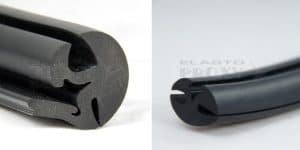Gasket corners can be fabricated via several different methods. By understanding the advantages of disadvantages of each gasket bonding technique, engineers can specify the best finished gaskets for their sealing application. In this week’s article from Elasto Proxy, we’ll compare injection molding with cold bonding for gasket corners. A future article will compare hot splicing vs. vulcanizing.
Injection Molding for Gasket Corners
Injection molding for gasket corners is recommended for sealing applications that require radiused joints, or that need to withstand stretching or high cycle times. Because metal tooling is required, injected molded corners are more expensive to produce than cold bonded corners. Yet injection molding also supports custom rubber gaskets with an enhanced appearance.
Unlike cold bonding, injection molding requires metal tooling and a C-press machine. First, uncured rubber is heated and injected into channels in the bottom half of the mold. The top half of the mold is then pressed down on the bottom half. Cut lengths are positioned in each half of the tool. The corners are formed, the top plate or mold half is removed, and cooling occurs.
Injection molding for custom rubber gaskets can be used with neoprene, EPDM, PVC, or Viton.
- Molded neoprene gaskets provide good resistance to oil, petroleum, water, and weather.
- Molded EPDM gaskets have excellent weather resistance to ozone, sunlight, oxygen, and weather.
- Molded PVC gaskets are strong, lightweight, and are inherently fire-resistant.
- Molded Viton gaskets provide fuel-resistance at extreme temperatures.
Molded gasket corners are used only with solid rubber profiles. They are not suitable for sponge rubber or silicones. Elasto Proxy has not molded the corners for thermoplastic elastomers (TPE).
Cold Bonded Corners
Rubber gaskets with cold bonded corners are recommended for lower-volume projects because cold bonding doesn’t require tools or molds. Metal tooling can add significant costs to gasket fabrication – sometime as much as tens of thousands of dollars. Higher-volume projects can spread the costs of tools across many finished gaskets, but the per-gasket cost for a mold may be too high for a low-volume project.
Unlike C-press injection molding, cold bonding is an entirely manual process. First, production personnel clean and dry the surfaces of the cut lengths. To promote optimum adhesion, some rubber may need to be abraded. Next, a glue or adhesive is applied with a brush. There are many different rubber bonding systems, and some glues or adhesives are designed for specific elastomers.
For engineers, it’s important to understand that some glues crystallize when they contact water. All glues dry out over time. The right gasket fabricator can help with adhesive selection and also allocate labor resources to medium-volume jobs where cold bonding remains cost-effective. Cold bonded gaskets won’t last as long as other types of finished gaskets, but cold bonding offers important advantages.
Determining whether cold bonding is right for your application isn’t just about understanding how the process works or how much it costs. Engineers need to analyze all the tradeoffs that are involved, especially compared to other available joining methods. By working closely with the right gasket fabricator, you can choose the bonding method that’s best for your sealing application.
Finished Gaskets and Custom Fabrication
Elasto Proxy is a gasket fabricator that provides cold bonding, C-press injection molding, hot splicing, and vulcanizing services. If your project requires finished gaskets, we can also add value by providing design assistance and help with material selection. We use water jet cutting to create fine, fast cuts that are ready to bond with whatever joining method you require.
Elasto Proxy has three C-press molding machines at its headquarters near Montreal, Canada. Once your mold is made, Elasto Proxy can store it for you and use it repeatedly. If you need cold bonded gaskets instead, we can help you with adhesive selection and even allocate additional labor resources for higher-volume quantities. Our Simpsonville, South Carolina (USA) facility also has bonding or joining capabilities.
For more information, contact us.









